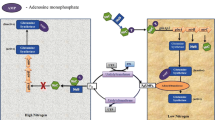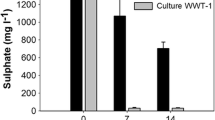Abstract
Sulfate-rich wastewater effluents from the mining and mineral industries and long chain fatty acids (LCFAs) from the dairy industries are a major concern for contamination due to their toxic effects on microbial populations. Diversion of electron fluxes from glucose degradation and inhabitation of LCFAs in mixed anaerobic microbial communities is the remedy for these toxicity effects. Two cases were studied to get a better understanding of the pattern of electron flux in mixed microbial cultures. In the first case, electron flux was investigated in the presence of an inorganic terminal electron acceptor, sulfate, and in the second case, proton was a terminal electron acceptor in the absence of sulfate. In both cases, methanogenesis, a terminal metabolic stage in the anaerobic degradation of organic matter, was inhibited by LCFAs containing 18 carbons and the electron fluxes were subsequently redirected to the desired terminal product formation. In these studies, the LCFAs under consideration were LA, OA and SA. Diverting electron fluxes from glucose to SRBs (for sulfate reduction) were observed in LA and OA-fed cultures, although SA had no significant effect on sulfate elimination. This was due to the inhibitory effect of LA and OA on the methanogenic populations. In comparison to glucose plus sulfate controls, OA and LA selectively inhibited methanogens at all concentrations and caused a metabolic shift in the syntrophic electron consumption pathway. The highest degree of sulfate reduction in glucose receiving cultures with LA, OA and SA was found to be 92%, 72%, and 31% respectively.
Access this chapter
Tax calculation will be finalised at checkout
Purchases are for personal use only
Similar content being viewed by others
References
Ahmed W, Rodríguez J (2018) Modelling sulfate reduction in anaerobic digestion: complexity evaluation and parameter calibration. Water Res 130:255–262
Cetecioglu Z, Dolfing J, Taylor J, Purdy KJ, Eyice Ö (2019) COD/sulfate ratio does not affect the methane yield and microbial diversity in anaerobic digesters. Water Res 155:444–454
Dasa KT, Westman SY, Millati R, Cahyanto MN, Taherzadeh MJ, Niklasson C (2016) Inhibitory effect of long-chain fatty acids on biogas production and the protective effect of membrane bioreactor. BioMed Res Int
Gibson GR (1990) Physiology and ecology of the sulfate-reducing bacteria. J App Bacteriology 69:769–797
Greenway KGA, Dyke KGH (1979) Mechanism and the inhibitory action of linoleic acid on the growth of Staphylococcus aureus. J Gen Microbiol 155:233–245
Hao OJ, Chen JM, Huang L, Buglass RL, (1996). Sulfate–reducing bacteria. Cri Rev Env Sci TechnoL 26:155–187
Lens P, Visser A, Janssen A, Hulshoff Pol L, Lettinga G (1998) Biotechnological treatment of sulfate rich wastewaters. Crit Rev Environ Sci Technol 28:41–88
Ma J, Zhao QB, Laurens LL, Jarvis EE, Nagle NJ, Chen S, Frear CS (2015) Mechanism, kinetics and microbiology of inhibition caused by long-chain fatty acids in anaerobic digestion of algal biomass. Biotechnol Biofuels 8:141
Madigan MT, Martinko JM, Parker J (2000) Brock biology of microorganisms. Prentice-Hall Inc.NJ, USA, pp 574–634
Ray S, Saady N, Lalman J (2009) Diverting electron fluxes to hydrogen in mixed anaerobic communities fed with glucose and unsaturated C18 long chain fatty acids. J Environ Eng 136(6):568–575
Shin HS, Kim SH, Lee CY, Nam SY (2003) Inhibitory effects of long-chain fatty acids on VFA degradation and β-oxidation. Water Sci Technol 47(10):139–146
Sousa DZ, Salvador AF, Ramos J, Guedes AP, Barbosa S, Stams AJ, Madalena Alves M, Pereira MA (2013) Activity and viability of methanogens in anaerobic digestion of unsaturated and saturated long-chain fatty acids. Appl Environ Microbiol 79(14):4239–4245
Stams AJM, Plugge CM, De Bok FAM, Van Houten BHGW, Lens P, Dijkman H, Weijma J (2005) Metabolic interactions in methanogenic and sulfate-reducing bioreactors. Water Sci Technol 52:13–20
Yang F, Bai L, Li P, Li Q, Luo L, Li W (2019) Improved methane production and sulfate removal by anaerobic co-digestion corn stalk and levulinic acid wastewater pretreated by calcium hydroxide. Sci Total Environ 691:499–505
Zan F, Hao T (2020) Sulfate in anaerobic co-digester accelerates methane production from food waste and waste activated sludge. Bioresour Technol 298:122536
Acknowledgements
This study was sponsored by NSERC Canada.
Author information
Authors and Affiliations
Corresponding author
Editor information
Editors and Affiliations
Rights and permissions
Copyright information
© 2023 Canadian Society for Civil Engineering
About this paper
Cite this paper
Ray, R., Sharma, M., Biswas, N. (2023). Diversion of Electron in Mixed Microbial Culture to Treat the High Sulfate and LCFA Contaminated Wastewater Treatment. In: Walbridge, S., et al. Proceedings of the Canadian Society of Civil Engineering Annual Conference 2021 . CSCE 2021. Lecture Notes in Civil Engineering, vol 249. Springer, Singapore. https://doi.org/10.1007/978-981-19-1061-6_21
Download citation
DOI: https://doi.org/10.1007/978-981-19-1061-6_21
Published:
Publisher Name: Springer, Singapore
Print ISBN: 978-981-19-1060-9
Online ISBN: 978-981-19-1061-6
eBook Packages: EngineeringEngineering (R0)




